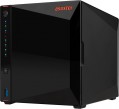3.5" drive slots
The number of slots for drives in the form factor 3.5", provided in the design of the server.
Initially, 3.5 "is the traditional, most popular form factor of drives for server systems. It is noticeably larger than 2.5", but it allows you to create capacious, inexpensive (in terms of gigabytes) and reliable media, in which it is also easier to implement various additional functions. That is why, specifically in NAS servers, this form factor is also the most popular; slots under 2.5" are much less common in such equipment, and in most cases they complement 3.5".
As for the number of slots, it can vary from 2 (or even 1) in the most basic desktop systems to 8 or more in professional rack-mount solutions. And not only their maximum capacity depends on the specific number of drives, but also some other features of work — first of all, the physical possibility of using one or another RAID level.
Max. storage capacity
This item characterizes the maximum capabilities of the device for connecting drives. This way you can understand how much maximum memory can be added to the NAS server.
Operating system
The operating system (OS) installed on the NAS server as standard. The OS is the software basis for the functioning of any computer; it is impossible to use the machine without it. Accordingly, when purchasing a server with a pre-installed OS, you get a practically ready-to-use device — additional steps, in fact, come down to fine-tuning the system and installing (if necessary) additional software.
Various specialized applications are available for different operating systems to facilitate the use of NAS server functions; some of them (see "Programme Features") may also be preinstalled. Accordingly, knowing the name of the OS, it is possible, to a certain extent, to determine the tools available for working with the device.
Note that some operating systems are paid, and their cost is included in the price of the NAS.
CPU
The model and specifications of the processor installed in the NAS server. The speed of the device largely depends on these characteristics, primarily the clock frequency. However, in fact, this parameter is often more of a reference value: simple everyday tasks (say, FTP and print servers, see "Software Features") do not require high computing power. But for working with extensive databases (see ibid.), a “faster” processor may be useful.
CPU cores
The number of cores provided in the processor of the NAS server.
Initially, each core is a computing module designed to execute one sequence of instructions. Accordingly, multiple cores make it possible to work simultaneously with multiple data streams, which improves flow Rate - especially when processing multiple tasks at the same time. Also, in modern CPUs, multithreading technologies are increasingly being used, which allow loading each core with two sequences of commands at once. During the inevitable pauses in the execution of one of the threads, the kernel does not idle, but works with another sequence. As a result, the total number of threads in such processors is twice the number of cores; this scheme of work even more noticeably improves flow Rate.
It is also worth remembering that the overall capabilities of the processor are highly dependent on a number of other characteristics - microarchitecture, clock speed, support for special functions, etc. This means that a large number of cores does not in itself guarantee high flow Rate: for example, an inexpensive mobile
processor on 4 cores may well be "weaker" than an advanced desktop chip
with only 2 cores. However, if we are talking about a CPU with a similar specialization and clock speed, then a solution with a large number of cores (
6 cores,
8 cores, or ev
...en more) and multithreading support usually turns out to be more productive.CPU speed
Clock speed of the processor installed in the NAS server.
The clock frequency is the frequency of the built-in oscillator, according to which all operations performed by the processor are synchronized. The higher this frequency, the more operations per second the CPU can perform and the easier it is to provide high computing power in it. However, note that the actual speed of the processor depends on many other features — the number of cores (see above), microarchitecture, volumes of the built-in cache memory, etc. So, only chips with similar characteristics and purpose can be directly compared by clock frequency ( desktop/mobile) and price category.
TurboBoost frequency
Processor clock speed achieved in TurboBoost or TurboCore "overclocking" mode.
Turbo Boost and Turbo Core technologies are used by different manufacturers (Intel and AMD, respectively), but they have the same principle of operation: load distribution from more loaded processor cores to less loaded ones to improve performance. The "overclocking" mode is characterized by an increased clock frequency, and it is indicated in this case.
For more information about clock speed in general, see the relevant paragraph above.
RAM
The amount of RAM on the NAS server. Along with the processor, it is one of the indicators that determine the speed of the system — the more memory, the higher the computing power. However, in fact, it does not always make sense to chase large amounts of "RAM", which can reach
4 GB,
8 GB and even higher; see "Processor" for details.
Power consumption
The amount of power consumed by the NAS server during normal operation. Most often, we are talking about maximum power consumption — with all the occupied slots for drives, under high load.
Modern NAS, even high-performance ones, have rather modest power consumption — even among professional models with 10 or more drives, this figure rarely exceeds 1 kW. So there are no problems with connecting to a 230 V network. However, energy consumption information can be useful for some special applications, primarily for estimating the load on UPSs, emergency generators, stabilizers, and other special equipment.

